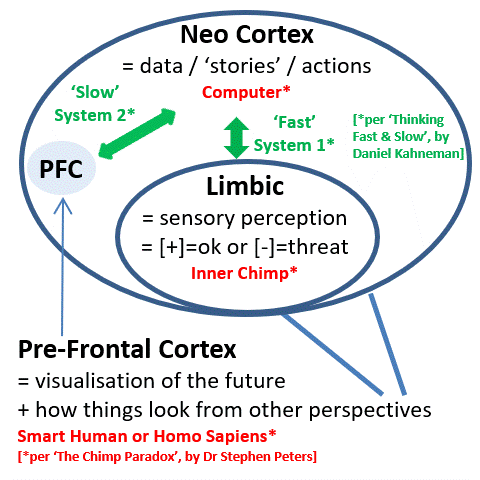


This model explains how 'fear' literally switches off 'smart'
On 'autopilot', your Limbic uses stored thinking / actions to react fast to what it perceives is happening...
Perception is created by matching sensory data to data and predictive models ('stories') about the world stored in your Neo Cortex. The instinctive reactions to perceived threat are often unhelpful in business, eg narrowed focus on the threat, avoiding the issue, over-thinking of actions, reduced flexibility (rigidity), reduced sensitivity, distrust of others.
In 'smart' mode you use your slower PFC to think more strategically and make new choices of actions...
Two issues: (a) it is easily over-loaded; (b) closing down the PFC is another instinctive reaction to threat. It is just not possible to use the PFC when too tired, or in the grip of fear (or anger). You need to be in the right state to be 'smart'.
Threats perceived by the Limbic are often (internally) created from 'stories' rather than being (externally) 'real'...
Imagined threats can be triggered by your personality, the system, and your relationships with other people in it. You can train yourself to calm your reactions to perceived threat - eg: physically by 'breathing'; cognitively by 're-framing'.
Regular practices can turn new perception / new responses into stored patterns, ie new habits...
Regular self-reflection, to review and modify your perception of situations, can literally create new neuronal pathways. Mindfulness practices can reduce your instinctive reaction to perceived threats. Coaching helps when you can't change perception on your own - with a strong connection to the coach, it's as if you can borrow their Limbic / their perception.
"We're simpler than we WANT to believe" MB
For occasional insights based on applying these ideas in real life, please follow this link to the equivalent "chapter" of my blog site:
